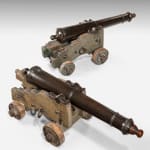Pair of Armstrong-Frederick pattern half-pounder Bronze Cannon
33 x 99 x 43 cm
Provenance
The Earls of Macclesfield, Shirburn Castle.Inscribed ‘½ Pr’ on the trunnion, each inscribed with the weight on the breech: ‘0.3.12’ and ‘0.3.13’. On their original carriages retaining the original paintwork, with original tompions, the sponge rod (damaged), ladle rod, and priming rod.
In the early 18th Century, armies and navies began to standardise the dimensions and calibers of their artillery. Gun design was controlled centrally by the Board of Ordnance and, in 1722, Colonel John Armstrong became Surveyor-General of Ordnance and held this position for 20 years, until 1742. Responsible for the quality of canon, by 1725 he had created a complex series of proportions, directing and standardising the dimensions of every component of the canon. Modifications were made to the Armstrong pattern in 1753, under the guidance of Charles Frederick as Surveyor-General, creating the Armstrong-Frederick pattern gun, the pattern used for our pair of canon.
The Armstrong and Armstrong-Frederick gun pattern was not superseded until the 1790s, when the Blomefield pattern gun was created. The Armstrong pattern was successful and robust, demonstrated by its presence on British warships as late as 1808.
This type of lightweight cannon was probably made for a private yacht although it is conceivable that they were made simply for domestic use. Identical cannon were used to arm ‘The Charlotte’ – a small naval vessel with a crew of 8. Their remarkable state of conservation is most unusual and is a result of them remaining in the Macclesfield Armoury for generations.
Shirburn Castle’s armoury was re-modelled as a vaulted Gothick-style entrance hall in the early 19th Century: ‘The north range, when Brewer described it in 1819, contained the ‘capacious’ north library over the armoury and also on the ground floor were marble baths, both warm and cold, ‘a luxury that too tardily creeps on the notice of this country’.(fn. 42) The armoury was the present entrance hall which had probably been comparatively recently remodelled in the ‘Gothic’ taste and was shortly to be illustrated in Skelton’s Antiquities of Oxfordshire. (fn. 43)’ – Taken from: ‘Parishes: Shirburn’, in A History of the County of Oxford: Volume 8, Lewknor and Pyrton Hundreds, ed. Mary D Lobel (London, 1964), pp. 178-198.




